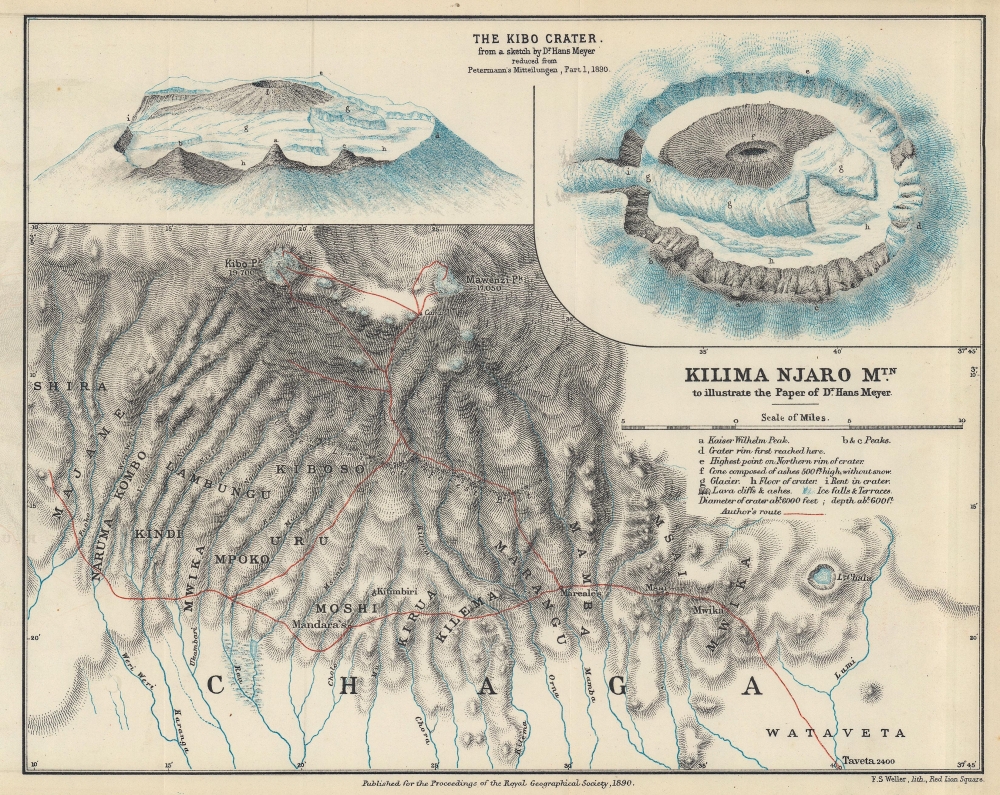This item has been sold, but you can get on the Waitlist to be notified if another example becomes available, or purchase a digital scan.
1890 Meyer Map of Mount Kilimanjaro, Tanzania
KilimanjaroMtn-meyer-1890
Title
1890 (dated) 8.75 x 10.75 in (22.225 x 27.305 cm) 1 : 253440
Description
A Closer Look
Three images occupy the present sheet. The largest, using a red line, traces the route of Meyer's expedition from Taveta to the peak of both Kibo and Mawenzi, Kilimanjaro's primary summits. (Meyer summited Kibo but was forced to turn back before summiting Mawenzi). Their stops and camps are noted. Kilimanjaro's many rivers appear along with a few other notes, including the 'upper limit of [the] forest belt'. The top two drawings illustrate Kibo Peak and detail the crater. Features are labeled alphabetically and correspond with a key below the title. Among these include the crater's rim, Uhuru Peak (named Kaiser Wilhelm Peak by Meyer in 1889), and several glaciers.Meyer's Successful 1889 Expedition to Mount Kilimanjaro
After two unsuccessful expeditions to summit Kilimanjaro, Meyer decided to try once more, this time recruiting celebrated Austrian mountaineer Ludwig Purtscheller to accompany him. Meyer also recruited a much more extensive climbing team, which included porters, a cook, and a guide. Meyer and Purtscheller reached the summit on the south rim of Kibo crater on Purtscheller's 40th birthday and Meyer named the summer Kaiser Wilhelm Spitze, which is now known as Uhuru. They attempted to climb Mawenzi after descending Kibo but did not reach its highest summit due to illness. Today, the highest summit on Mawenzi is known as Hans Meyer Peak in his honor.Publication History and Census
This map was reduced from a sketch created by Hans Meyer (and published in Petermann's Mitteilungen) by Francis Sidney Weller for publication by the Royal Geographical Society and Edward Stanford in the June 1890 edition of Proceedings of the Royal Geographical Society. We note a single cataloged example of the separate map: the British Library.CartographerS
Hans Heinrich Josef Meyer (March 22, 1858 - July 5, 1929) was a German geographer who is credited with being the first European to summit Mount Kilimanjaro. Born in Hildburghausen, Meyer studied history and science in Leipzig, Berlin, and Strasburg, after which he traveled the world, including North America, India, and South Africa. In 1884, he joined his father's (Herrmann Julius Meyer (1826 - 1909)) publishing firm, the Bibliographisches Institut in Leipzig. He became one of the directors the following year. Meyer led three expeditions to Kilimanjaro or the region in 1887, 1888, and 1889 respectively. He made his first summit attempt in 1887, but was forced to turn back at the base of Kibo (one of Kilimanjaro's three summits), discovering he lacked the necessary equipment for deep snow and ice. The following year, 1888, he and Austrian cartographer Oscar Baumann explored the Usambara region with the intention of continuing to Kilimanjaro, but were forced to cut their expedition short due to the s-called Abushiri Revolt. (Both men were captured and held as prisoners and were only released after a large ransom was paid.) Meyer returned to Kilimanjaro in 1889, this time with Ludwig Purtscheller, the celebrated Austrian mountaineer. Meyer and Purtscheller reached the summit of Kibo on October 6, 1889, Purtscheller's 40th birthday. Kibo would not be summitted again until for another twenty years. Meyer became a professor at the University of Leipzig in 1889 and was appointed director of the Institute of Colonial Geography at the University of Leipzig in 1915. Meyer also undertook mountain climbing expeditions in the Canary Islands and Ecuador. More by this mapmaker...
Francis Sidney Weller (April 1849 - 1910) was an English engraver, lithographer, map publisher, and cartographer based in London. He was the son of Edward Weller (July 1, 1819 - 1884) and is named after another important map publisher, Sidney Hall. F. S. Weller took over his father's printing business in 1884. This is the same business that was founded by John Thomson, passed to Sidney Hall, who managed it from 1814 to 1831, then to his widow Selina Price Hall, who ran it to 1853, when it was taken over by his nephew Edward Weller, who rat it until 1884. Weller passed it to his son, Frances Sidney Weller. Learn More...
Royal Geographical Society (fl. 1830 - present) is a British Society established in 1830 to promote geographical science and exploration. Originally titled the "Geographical Society of London", the RGS received its royal charter from Queen Victoria in 1859 shortly after absorbing several similar but more regional societies including the African Association, the Raleigh Club and the Palestine Association. The RGS sponsored many of the most important and exciting voyages of exploration ever undertaken, including the exploration of Charles Darwin, David Livingstone, Robert Falcon Scott, Richard F. Burton, John Speke, George Hayward, H. M Stanley, Ernest Shackleton and Sir Edmond Hillary. Today, the RGS remains a leading global sponsor of geographical and scientific studies. The Society is based in Lowther Lodge, South Kensington, London. Learn More...
Edward Stanford (May 27, 1827 - November 3, 1904) was one of the most prolific map publishing firms of the late 19th century. The company began as a partnership in 1848 between the 21 year old Edward Stanford and the established map dealer Trelawney Saunders. By 1853 the partnership had dissolved and Edward Stanford took full control of the business. A subsequent series of expansions and exciting new map issues finally led to the production of Stanford's masterwork, "Stanford's Library Map of London". This map is still available and remains somewhat accurate. At the time of publishing it was hailed by the Royal Geographical Society as "the most perfect map of London that has ever been issued". In 1882 Edward Stanford Sr. passed the firm on to his son, Edward Stanford Jr. who continued in his father's proud tradition. Today the Stanford firm still publishes maps and remains one of the most important and prolific cartographic publishers in the world. Learn More...

